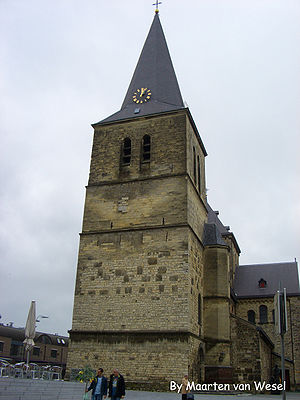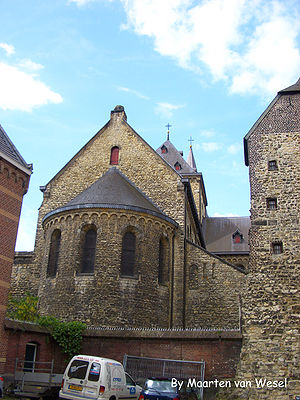
Pancratiuskerk
Encyclopedia



Heerlen
Heerlen is a city and a municipality in the southeastern Netherlands. The municipality is the second largest in the province of Limburg. It forms part of Parkstad Limburg, , an agglomeration of about 220,000 inhabitants.After its early Roman beginnings and a rather modest medieval period, Heerlen...
in the Netherlands
Netherlands
The Netherlands is a constituent country of the Kingdom of the Netherlands, located mainly in North-West Europe and with several islands in the Caribbean. Mainland Netherlands borders the North Sea to the north and west, Belgium to the south, and Germany to the east, and shares maritime borders...
.
History
Although no written sources about the origin of the church are known, a comparative study (including among others Onze-Lieve-Vrouwebasiliek in MaastrichtMaastricht
Maastricht is situated on both sides of the Meuse river in the south-eastern part of the Netherlands, on the Belgian border and near the German border...
) concludes that building started in the first half of the 12th century . However, since this study the age of both Onze-Lieve-Vrouwebasiliek and the church of Rolduc
Rolduc
Rolduc is the name of a medieval abbey in Kerkrade, the Netherlands, which is now a Roman Catholic seminary and an affiliated conferencing center.-History:...
have been pushed back two centuries. It is suggested that the building of the Pancratiuskerk also started earlier, the 11th and possibly 10th century are most likely .
It is believed that the building was commissioned by the counts of Ahr-Hochstaden in the Rhineland
Rhineland
Historically, the Rhinelands refers to a loosely-defined region embracing the land on either bank of the River Rhine in central Europe....
, then the lords of Heerlen .
The current bell tower
Bell tower
A bell tower is a tower which contains one or more bells, or which is designed to hold bells, even if it has none. In the European tradition, such a tower most commonly serves as part of a church and contains church bells. When attached to a city hall or other civic building, especially in...
was built in 1394, and for the size of the church at that time was of a relatively heavy construction. The tower served as part of the defense mechanism for the Landsfort Herle
Landsfort Herle
Landsfort Herle was a fortification with moat in, what now is, the centre of Heerlen , it was probably built by the counts van Ahr-Hochstaden . The name Landsfort comes from the fact that the fortification come under the responsibility of the land...
.
From 1632 till 1836 the Pancratiuskerk served as a church for both Catholics and Protestants. The Protestants obtained their own church in 1836 and the arrangement ended..
A stair tower, located on the south side of the bell tower was built in 1862 .
Between 1901 and 1903 Joseph Cuypers renovated and enlarged the church. The choir was demolished and replaced by a new eastern part, with a transept
Transept
For the periodical go to The Transept.A transept is a transverse section, of any building, which lies across the main body of the building. In Christian churches, a transept is an area set crosswise to the nave in a cruciform building in Romanesque and Gothic Christian church architecture...
, crossing tower and a new choir, all in neo-romanesque style and using marl
Marl
Marl or marlstone is a calcium carbonate or lime-rich mud or mudstone which contains variable amounts of clays and aragonite. Marl was originally an old term loosely applied to a variety of materials, most of which occur as loose, earthy deposits consisting chiefly of an intimate mixture of clay...
stone.
Frits Peutz
Frits Peutz
F.P.J. Peutz was a Dutch architect.Peutz was born in a Catholic family in Uithuizen in Groningen, a mostly Protestant province in the north of the Netherlands. In 1910 he was sent to the Rolduc boarding school in Kerkrade in the Catholic province of Limburg for his higher education. In 1914 he...
, best known for the Glaspaleis
Glaspaleis
The Glaspaleis is a modernist building in Heerlen, Netherlands, built in 1935. Formerly a fashion house and department store, Schunck, it is now the cultural centre of the city...
located on the same square, supervised the repair of war damage between 1945 and 1948 .
In 1960 a sacristy
Sacristy
A sacristy is a room for keeping vestments and other church furnishings, sacred vessels, and parish records.The sacristy is usually located inside the church, but in some cases it is an annex or separate building...
and a baptistry were built on the south side.
The current interior is a mixture of an interior created by Pierre Cuypers
Pierre Cuypers
Petrus Josephus Hubertus Cuypers was a Dutch architect. His name is most frequently associated with the Amsterdam Central Station and the Rijksmuseum , both in Amsterdam. More representative for his oeuvre, however, are numerous churches, of which he designed more than 100...
in 1880 and a modernisation of 1969. Fresco
Fresco
Fresco is any of several related mural painting types, executed on plaster on walls or ceilings. The word fresco comes from the Greek word affresca which derives from the Latin word for "fresh". Frescoes first developed in the ancient world and continued to be popular through the Renaissance...
es created by Charles Eyck decorate parts of the ceiling.
The stained glass
Stained glass
The term stained glass can refer to coloured glass as a material or to works produced from it. Throughout its thousand-year history, the term has been applied almost exclusively to the windows of churches and other significant buildings...
windows dating from between 1947 until the 1960s was created by Eugène Laudy and include Saint Nicholas
Saint Nicholas
Saint Nicholas , also called Nikolaos of Myra, was a historic 4th-century saint and Greek Bishop of Myra . Because of the many miracles attributed to his intercession, he is also known as Nikolaos the Wonderworker...
, Saint Andrew
Saint Andrew
Saint Andrew , called in the Orthodox tradition Prōtoklētos, or the First-called, is a Christian Apostle and the brother of Saint Peter. The name "Andrew" , like other Greek names, appears to have been common among the Jews from the 3rd or 2nd century BC. No Hebrew or Aramaic name is recorded for him...
, Saint Barbara
Saint Barbara
Saint Barbara, , Feast Day December 4, known in the Eastern Orthodox Church as the Great Martyr Barbara, was an early Christian saint and martyr....
, and Saint Servatius
Saint Servatius
Saint Servatius was bishop of Tongeren—Roman Atuatuca Tungrorum the capital of the Tungri—one of the earliest dioceses in the Low Countries. Later in his life he fled to Maastricht, Roman Mosae Trajectum, where he became the first bishop of this city...
.
Architectural features
The building is a triple-aisled cruciform church in the RomanesqueRomanesque architecture
Romanesque architecture is an architectural style of Medieval Europe characterised by semi-circular arches. There is no consensus for the beginning date of the Romanesque architecture, with proposals ranging from the 6th to the 10th century. It developed in the 12th century into the Gothic style,...
style.


